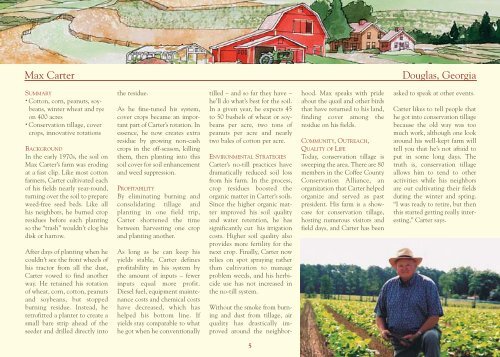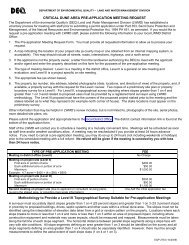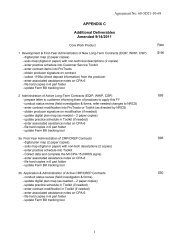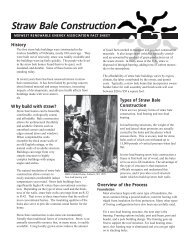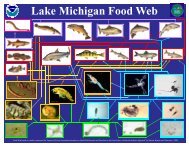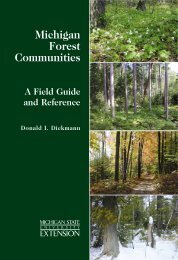Exploring Sustainability in Agriculture - Green Building Center
Exploring Sustainability in Agriculture - Green Building Center
Exploring Sustainability in Agriculture - Green Building Center
Create successful ePaper yourself
Turn your PDF publications into a flip-book with our unique Google optimized e-Paper software.
Max Carter<br />
Douglas, Georgia<br />
SUMMARY<br />
• Cotton, corn, peanuts, soybeans,<br />
w<strong>in</strong>ter wheat and rye<br />
on 400 acres<br />
• Conservation tillage, cover<br />
crops, <strong>in</strong>novative rotations<br />
BACKGROUND<br />
In the early 1970s, the soil on<br />
Max Carter’s farm was erod<strong>in</strong>g<br />
at a fast clip. Like most cotton<br />
farmers, Carter cultivated each<br />
of his fields nearly year-round,<br />
turn<strong>in</strong>g over the soil to prepare<br />
weed-free seed beds. Like all<br />
his neighbors, he burned crop<br />
residues before each plant<strong>in</strong>g<br />
so the “trash” wouldn’t clog his<br />
disk or harrow.<br />
After days of plant<strong>in</strong>g when he<br />
couldn’t see the front wheels of<br />
his tractor from all the dust,<br />
Carter vowed to f<strong>in</strong>d another<br />
way. He reta<strong>in</strong>ed his rotation<br />
of wheat, corn, cotton, peanuts<br />
and soybeans, but stopped<br />
burn<strong>in</strong>g residue. Instead, he<br />
retrofitted a planter to create a<br />
small bare strip ahead of the<br />
seeder and drilled directly <strong>in</strong>to<br />
the residue.<br />
As he f<strong>in</strong>e-tuned his system,<br />
cover crops became an important<br />
part of Carter’s rotation. In<br />
essence, he now creates extra<br />
residue by grow<strong>in</strong>g non-cash<br />
crops <strong>in</strong> the off-season, kill<strong>in</strong>g<br />
them, then plant<strong>in</strong>g <strong>in</strong>to this<br />
soil cover for soil enhancement<br />
and weed suppression.<br />
PROFITABILITY<br />
By elim<strong>in</strong>at<strong>in</strong>g burn<strong>in</strong>g and<br />
consolidat<strong>in</strong>g tillage and<br />
plant<strong>in</strong>g <strong>in</strong> one field trip,<br />
Carter shortened the time<br />
between harvest<strong>in</strong>g one crop<br />
and plant<strong>in</strong>g another.<br />
As long as he can keep his<br />
yields stable, Carter def<strong>in</strong>es<br />
profitability <strong>in</strong> his system by<br />
the amount of <strong>in</strong>puts – fewer<br />
<strong>in</strong>puts equal more profit.<br />
Diesel fuel, equipment ma<strong>in</strong>tenance<br />
costs and chemical costs<br />
have decreased, which has<br />
helped his bottom l<strong>in</strong>e. If<br />
yields stay comparable to what<br />
he got when he conventionally<br />
tilled – and so far they have –<br />
he’ll do what’s best for the soil.<br />
In a given year, he expects 45<br />
to 50 bushels of wheat or soybeans<br />
per acre, two tons of<br />
peanuts per acre and nearly<br />
two bales of cotton per acre.<br />
ENVIRONMENTAL STRATEGIES<br />
Carter’s no-till practices have<br />
dramatically reduced soil loss<br />
from his farm. In the process,<br />
crop residues boosted the<br />
organic matter <strong>in</strong> Carter’s soils.<br />
S<strong>in</strong>ce the higher organic matter<br />
improved his soil quality<br />
and water retention, he has<br />
significantly cut his irrigation<br />
costs. Higher soil quality also<br />
provides more fertility for the<br />
next crop. F<strong>in</strong>ally, Carter now<br />
relies on spot spray<strong>in</strong>g rather<br />
than cultivation to manage<br />
problem weeds, and his herbicide<br />
use has not <strong>in</strong>creased <strong>in</strong><br />
the no-till system.<br />
Without the smoke from burn<strong>in</strong>g<br />
and dust from tillage, air<br />
quality has drastically improved<br />
around the neighborhood.<br />
Max speaks with pride<br />
about the quail and other birds<br />
that have returned to his land,<br />
f<strong>in</strong>d<strong>in</strong>g cover among the<br />
residue on his fields.<br />
COMMUNITY, OUTREACH,<br />
QUALITY OF LIFE<br />
Today, conservation tillage is<br />
sweep<strong>in</strong>g the area. There are 80<br />
members <strong>in</strong> the Coffee County<br />
Conservation Alliance, an<br />
organization that Carter helped<br />
organize and served as past<br />
president. His farm is a showcase<br />
for conservation tillage,<br />
host<strong>in</strong>g numerous visitors and<br />
field days, and Carter has been<br />
asked to speak at other events.<br />
Carter likes to tell people that<br />
he got <strong>in</strong>to conservation tillage<br />
because the old way was too<br />
much work, although one look<br />
around his well-kept farm will<br />
tell you that he’s not afraid to<br />
put <strong>in</strong> some long days. The<br />
truth is, conservation tillage<br />
allows him to tend to other<br />
activities while his neighbors<br />
are out cultivat<strong>in</strong>g their fields<br />
dur<strong>in</strong>g the w<strong>in</strong>ter and spr<strong>in</strong>g.<br />
“I was ready to retire, but then<br />
this started gett<strong>in</strong>g really <strong>in</strong>terest<strong>in</strong>g,”<br />
Carter says.<br />
5


